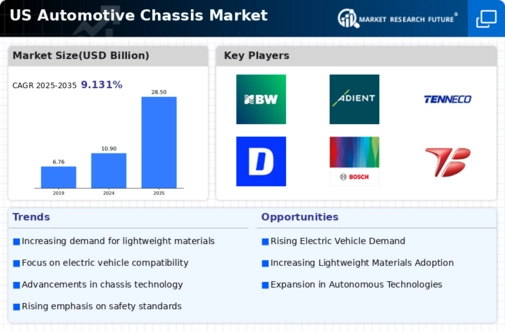The US Automotive Chassis Market is an integral component of the broader automotive sector, where chassis systems form the backbone of vehicle structure and functionality. This market is characterized by a diverse array of key players who bring innovative solutions and advanced technologies to meet the evolving demands of manufacturers and consumers alike. The competitive landscape showcases a blend of established firms and emerging entities that are continually striving to enhance performance, efficiency, and sustainability.
The market dynamics are shaped by various factors such as consumer preferences, regulatory standards, and technological advancements, which drive companies to innovate and differentiate their offerings. As a result, understanding the competitive insights provides vital information regarding leading strategies, market positioning, and growth potential within the industry.BorgWarner holds a notable position in the US Automotive Chassis Market, primarily recognized for its robust engineering capabilities and a commitment to advanced technologies. The company boasts a strong presence in the market, contributing to the chassis segment through its innovative solutions designed for improved performance and efficiency.
One of the key strengths of BorgWarner lies in its focus on propulsion systems, which allows it to create products that are not only aligned with the current trends of electrification but also enhance traditional vehicle platforms. This focus positions BorgWarner favorably among automakers seeking to meet stringent emission standards while also catering to consumer demands for enhanced driving experiences. The company's engineering expertise and strategic partnerships further empower it to respond swiftly to market changes, thereby maintaining its competitive edge.
Adient is another significant player within the US Automotive Chassis Market, recognized for its comprehensive portfolio that encompasses seating systems, which are an integral aspect of chassis design. Adient has established a substantial market presence, leveraging its design and manufacturing capabilities to deliver innovative seating solutions customized for various vehicle models. A distinct strength of Adient is its commitment to sustainability and advanced manufacturing processes, allowing it to cater to the growing demand for eco-friendly vehicle components.
Through a series of strategic mergers and acquisitions, the company has strengthened its position in the US market, enabling it to access new technologies and expand its service offerings. Adient's emphasis on research and development, combined with its rich experience in automotive seating, further reinforces its competitive stature, making it a key player in shaping the future of the US Automotive Chassis Market.




















